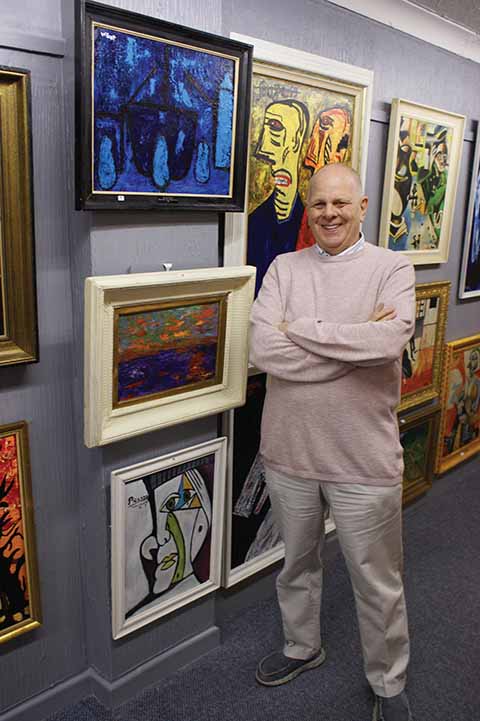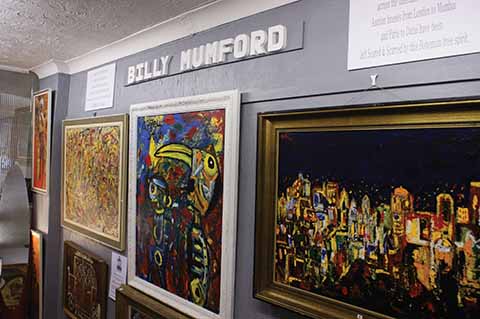Dorset Lives – Art for art’s sake
David Callaghan looks at the artistic enterprise of arts patron Jim Hartey
Published in December ’19

Jim with some of Billy Mumford’s works including a homage to Picasso at the bottom and, at the top, his version of British still-life painter William Scott’s ‘Blue Pot and Three Pears’. This was the painting that began Jim’s connection to Billy: ‘I bought it for myself, not to sell. Through that I met Billy and started buying his paintings.’ The original Scott painting sold at Christie’s in 2014 for £96,100.
IN HIS GLOBAL Art Gallery above the Bridge House Antiques Market at Longham, Jim Hartey is scrutinising a painting, as he has done hundreds of times before. Then he examines another very different painting, then another, and another.
Eventually he turns around and exclaims, ‘I don’t know how he does it. He’s a genius.’
The paintings Jim is looking at are forgeries, fakes and tributes to the work of great painters from Chagall and Picasso to Modigliani and Stubbs, as well as graffiti artist Jean-Michel Basquiat, contemporary abstract painter Gillian Ayres and celebrated Indian artist FN Sousa. All of them were made by the notorious forger, Billy Mumford – Billy the Brush – who was jailed for two years in 2012 after putting more than £6 million in fakes through some of the art world’s best-known auction houses including Christie’s, Sotheby’s and Bonhams.
‘Apart from Damien Hirst, I don’t think any living British artist has done as much as that,’ says Jim, who is now promoting Billy’s work, some of it made in his studio in Lytchett Matravers, as a legitimate investment in itself. ‘Billy can paint as well as any of the greats, yet none of them could paint like the others. He not only has to master each of their individual techniques, but also their materials, their finishes, their signatures and then in the bad old days he created all the letters and false provenance to go with them as well. The major art houses were taken in and they hate him for it. Of the 1100 paintings he made, only 40 came back and just fifteen were taken to court. As soon as he got out of prison, he went straight back to painting as that’s all he can do – he just has to paint. These days he doesn’t copy actual paintings, he produces versions, Billy Mumford versions.’
The gallery is just the latest in a long line of entrepreneurial activities that began well before Jim ended a seventeen-year Army career as Master Chef Warrant Officer in the 15th/19th Royal Hussars at Bovington Camp. In that time he cooked for every member of the Royal Family except the Prince of Wales, but also took outside catering jobs and did some buying and selling on the side. In the mid-1980s he made a home in Bournemouth and opened an antiques shop called Cobwebs. After a series of deals with bailiffs and other contacts, he found himself with 60,000 paintings in a lock-up in Lytchett, so when he was offered the chance to open a gallery earlier this year, he had no shortage of stock.
‘A mate worked out that if I sold ten a day, it would take thirty-three years to shift them all, so I had better thin them out a bit. I got really into researching the stories of the painters and once you know a bit about them, you see the work differently. It’s addictive – and it’s always the story that sells.’
Jim did not forget his background as a master chef and also went into a number of catering ventures. It was one of these some twenty years ago that has resulted in Jim’s most settled business venture to date. ‘I did the food at the Courtyard Centre from 1996 until 1999, then bought the centre itself and have run it ever since – I’m now the biggest employer in Lytchett Minster! I offer advice, but unless people want to be told, there’s not a lot I can do. I’ll always give someone a chance, though.’
That way of thinking is carried over into the gallery. ‘I do it because I can,’ says Jim. ‘I had two young lads in recently and to my shame I thought I had to keep an eye on them. After they’d been there a good hour, I asked what they liked and they told me – a painting and a sculpture that I’d never have guessed would take their eye. I offered them a price and they bought them. Now they come in regularly just to hang out. That’s what art can do and that’s what I want the gallery to be about – a bit of a hub for people.’

Jim takes a close look at one of Broadstone copyist Allan Hansford’s versions of work by French realist William-Adolphe Bouguereau
For his next scheme, Jim and a nameless local artist have founded a new art movement they’re calling ‘If-ism’, based on works of art that might have been made by great painters – in a parallel world, perhaps. ‘The first project is about LS Lowry. His mother died in 1939, but instead of retreating into himself, our story is that his benefactor paid for him to travel to New York to paint. So we’ve got the 1939 Macy’s Thanksgiving Day Parade, the World’s Fair and street scenes. We’ve written his diary for 30 days, there are three songs about the trip; it’s very detailed. The works are all made on old boards, aged to the right period and painted the way Lowry painted.’
Like the forgeries, the Lowry paintings are thoroughly convincing except, of course, that the artist cannot have made them. They are curiously mischievous, slightly unsettling and, to the untrained eye, supremely well executed – talking points with plenty to say. Just as he turns away from them, Jim casually delivers the ace up his sleeve. ‘I actually met Lowry,’ he imparts. ‘My dad took me to see him at an exhibition at the Monks Hall in Eccles. I don’t remember much about him, but it’s funny how things go full circle, isn’t it?’
And with that he’s off to inspect more paintings.


